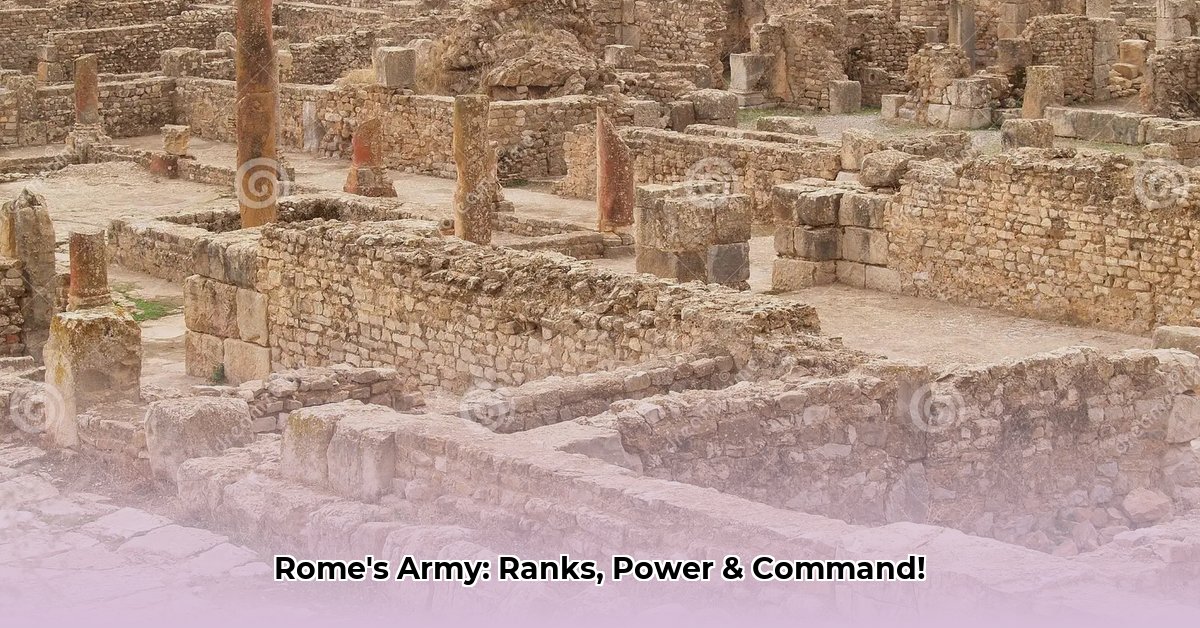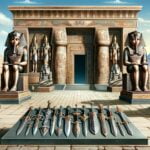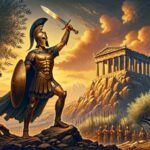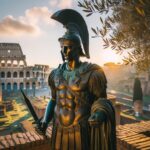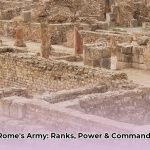Have you ever marveled at how the Roman army, a legendary war machine, conquered vast territories and maintained an empire for centuries? It wasn’t merely brute force or sharp swords; it was fundamentally about unparalleled organization, discipline, and an intricate hierarchy that mapped every soldier’s role. Think of it less as a disorganized mob and more like a perfectly synchronized ancient military corporation. This guide will meticulously peel back the layers of the Roman army ranks, exploring what each position truly signified, the rigorous training that forged formidable warriors, the often-debated pay they received, and the essential gear that defined their fighting style. We’ll also consider how this intricate command structure, a blueprint for battlefield efficacy, can be accurately portrayed in modern strategy games, museum exhibits, and even offer lessons for today’s leadership. So, let’s step into the dusty boots of a legionary and ascend through the command structure, understanding the profound power and enduring impact of Rome’s military might.
Understanding the Legion’s Hierarchy: A Blueprint of Might
The Roman legion was a marvel of military engineering, not just in its devastating siege engines, but in its human infrastructure. At its core, the legion operated on an unyielding chain of command, a blueprint for discipline and battlefield efficacy. Imagine a living pyramid: the vast base comprised the common foot soldiers, the legionaries, while the apex featured the supreme commanders. This meticulously structured system encompassed not just the citizen legions but also specialized cavalry units and vital auxiliary forces, each with their own distinct, yet integrated, structure. This hierarchy was the very foundation upon which Rome built and sustained its empire, ensuring that orders flowed efficiently from the top down and that every soldier understood their precise place, duty, and path for advancement.
A standard legion, typically consisting of 4,200 to 6,000 infantrymen (a number that fluctuated throughout Roman history), was divided into ten cohorts. Each cohort, a basic battlefield unit, usually comprised six centuries. The smallest unit, a contubernium, held eight men who shared a tent, forming the nucleus of camp life and initial bonds.
The Ranks: A Structured Path to Power
The path through the Roman military was a challenging ascent, demanding loyalty, unwavering courage, and often, a lifetime of dedication. Each step up the ladder bestowed greater responsibility, enhanced prestige, and often, significantly improved living conditions.
The Munifex and Legionarius: The Foundation of Rome’s Might
At the very bottom of this formidable structure stood the munifex, the common soldier, often burdened with the toughest labor. Yet, this was the crucible from which every legionarius, the professional Roman citizen-soldier, emerged, forming the very backbone of the army. These were not mere conscripts; they were highly trained, disciplined professionals.
Recruits, or tirones, endured brutal training that could last several months. They drilled endlessly, honing their weapon skills with practice weapons often twice the weight of their actual gear, and mastered complex formations. They learned to march tirelessly, sometimes covering 20 to 25 miles a day with full kit, their sturdy caligae (military boots) pounding the dusty roads. Discipline was paramount, instilled through relentless repetition and harsh penalties, ensuring unwavering obedience even under the most chaotic battle conditions.
Each legionarius was a walking arsenal, carrying a substantial amount of gear. Estimates suggest they hauled upwards of 66 pounds (30 kg), including their iconic lorica segmentata (segmented armor) or lorica hamata (chainmail), the sturdy scutum (rectangular shield), the short, deadly gladius (sword), the pilum (javelin), and a galea (helmet). This standardized equipment fostered unit cohesion and ensured a uniform fighting capability across the legion. While legionaries weren’t initially paid handsomely (a common legionary might earn around 225 denarii per year during the early Empire), they received a regular stipendium (stipend) and eagerly anticipated bonuses upon retirement.
Strategy game developers could realistically portray legionaries as units requiring high morale to perform optimally, directly affected by supply lines and leader presence. Museums, conversely, might display a recreated lorica segmentata, demonstrating its assembly and maintenance requirements, or details on the rigorous daily training regimens to visitors.
The Principales: Backbone of Discipline and Administration
Just above the common legionaries, yet still below the commissioned officers, stood the principales. These were the skilled non-commissioned officers (NCOs) who formed the crucial operational and administrative backbone of a century. These experienced soldiers had risen through the ranks, earning their positions through merit and reliability.
- Optio: As the centurion’s second-in-command, the optio was responsible for maintaining discipline, overseeing training, and ensuring the men stayed in formation during battle, often positioned at the rear of the century. They carried a wooden staff as a badge of office.
- Signifer: The century’s standard-bearer, the signifer, carried the signum, a spear decorated with medallions and often an open hand symbol. This standard served as a vital rallying point in battle. Distinguished by wearing animal pelts (like a bear or wolf skin) over their helmets, signifers also held the crucial responsibility of managing the century’s pay and savings accounts.
- Tesserarius: Named after the tessera, a wax tablet containing the day’s watchwords, the tesserarius was the guard commander, responsible for distributing these passwords and overseeing guard duty.
- Decanus: The most experienced man of the contubernium, the decanus was in charge of the eight men sharing a tent, overseeing their daily tasks and discipline within their small group.
- Cornicen/Tubicen: These horn-blowers and trumpet players conveyed orders and signals across the battlefield through specific calls, coordinating troop movements amidst the din of combat.
- Imaginifer: Each legion had an imaginifer who carried a standard bearing the image of the Emperor, a constant visual reminder of the oath of loyalty.
- Aquilifer: One of the most prestigious positions, the aquilifer carried the legion’s golden eagle standard (aquila). Losing the aquila was a grave dishonor, making this role immensely important and entrusted only to the most reliable soldiers. An aquilifer was often on the path to becoming a centurion.
The Centurion: The True Field Commanders
If the legionary was the muscle and the principales the sinew, the centurion was the driving force—the quintessential Roman officer who held the entire structure together. These were the true leaders on the ground, commanding a centuria, typically a unit of around 80 men. Their responsibilities were immense: they were directly accountable for the discipline, training, and combat effectiveness of their troops.
Centurions weren’t born into their positions; they earned them through years of distinguished service, proving their bravery, leadership, and unwavering loyalty in countless skirmishes and battles. Their experience was invaluable, often making the crucial difference between victory and defeat. Their pay was significantly higher than a common legionary’s, reflecting their status and the critical nature of their role. Some centurions could earn substantial sums, with a Pilus Prior potentially receiving 15,000 to 30,000 sestertii annually.
Among these hardened veterans, one stood out as the pinnacle of a career soldier’s ambition: the Primus Pilus (First File). This was the most senior centurion in an entire legion, the commander of the prestigious first cohort, which was often double-strength, comprising 160 men. The Primus Pilus not only led the most elite soldiers but also held a key role in strategic planning, attending war councils with senior commanders. This position was the highest a career soldier could aspire to, often leading to honorary knighthood (promotion to the equestrian order) upon retirement, and earning a staggering 60,000 sestertii annually.
Other senior centurions in the first cohort were known as the primi ordines, who outranked all other centurions in the legion. Below them, centurions were ranked by the position of their century within the cohort and legion, with titles like pilus prior, pilus posterior, princeps prior, princeps posterior, hastatus prior, and hastatus posterior indicating their seniority and historical lineage to earlier legionary formations.
A crucial requirement for a centurion was literacy in Latin, as they had to understand and relay written orders. In peacetime, they were responsible for the readiness of their men, including enforcing discipline with their vine staff, a badge of office also used for corporal punishment. One infamous centurion earned the nickname “Cedo Alteram” (“give me another”) due to his habit of breaking his staff over the backs of his men and calling for replacements, a testament to the harsh discipline they enforced.
In battle, the centurion was instantly recognizable by their distinct traverse crest on their helmet and their sword, which they wore on the left side (unlike legionaries who wore it on the right). They also sported more elaborate armor, including metal greaves and a harness adorned with awards earned during long service. The centurion’s primary job was to lead their men from the front, expected to be the first in every charge and the last in every retreat, leading by example as much as by authority. As a direct consequence of this frontline leadership, centurions suffered exceptionally high casualties during their service.
Higher Command: Senators, Equestrians, and Strategic Minds
Above the battle-hardened centurions sat the higher echelons of command, typically filled by men from Rome’s elite senatorial and equestrian classes. These officers brought both military and political influence to their roles, often using their service as a crucial stepping stone in their cursus honorum (path of honor) towards a distinguished political career.
- Legatus Legionis: At the helm of each legion stood the Legatus Legionis (Legionary Commander), usually a senator in his early thirties, appointed directly by the Emperor. This role was a delicate balance of military command, strategic planning, and political maneuvering. A legatus typically held the post for around four years, often residing in an elaborate praetorium within the camp, accompanied by lictores bearing fasces as symbols of his authority. In provinces with only one legion, the legatus often served as the provincial governor.
- Tribunus Laticlavius: The second-in-command of a legion, the tribunus laticlavius (broad-striped tribune) was a young senator gaining vital military experience. Named for the broad purple stripe on his toga—a mark of his senatorial rank—this role was a foundational step in a future political career, with duties assisting the legatus in overall legion management.
- Praefectus Castrorum: The third highest rank, the praefectus castrorum (camp prefect), was unique. Unlike the senatorial and equestrian officers, this man was typically a commoner and a highly experienced professional soldier, almost always a former Primus Pilus. Having spent decades in the army, the camp prefect possessed an invaluable wealth of practical knowledge regarding logistics, engineering, training, and the day-to-day operations of the legion. He would often assume command of the legion if the legatus was absent or unavailable.
- Tribuni Angusticlavii: Under these senior officers served five tribuni angusticlavii (narrow-striped tribunes). Drawn from the equestrian class, and named for the narrow purple stripe on their togas, these officers served primarily in administrative, logistical, or staff roles. They often commanded detached units (vexillations) for specific tasks, gaining valuable independent command experience beyond just auxiliaries.
- Legatus Augusti pro Praetore: At the highest military-political level was the Legatus Augusti pro Praetore, the military governor of an entire province. This officer commanded all legions within a province, overseeing military operations, maintaining order, and enforcing Roman law. These were critical roles combining military strategy with profound civil administration.
Beyond Citizens: The Crucial Role of Auxiliary Units
The Roman military’s genius extended far beyond its citizen legions. Auxiliary units, comprised of non-citizens recruited from across the vast, sprawling Empire, played an absolutely crucial role. These forces provided specialized skills that legionaries often lacked, such as the lightning-fast cavalry units from Gaul, formidable archers from the East, or agile light infantry from various provinces. Their integration significantly broadened the Roman army’s tactical capabilities and allowed for adaptability across diverse terrains and enemies.
These auxiliary units had their own distinct rank structures, though they often mirrored the legionary model in various capacities. For example, cavalry units called alae (wings) were made up of turmae (squadrons) of 32 men, commanded by a decurion who had a duplicarius as his second-in-command. The motivation for these non-citizens was powerful: after 25 years of honorable service, they and their families were granted the coveted Roman citizenship, a pathway to legal rights, social mobility, and full integration into the Roman world. This system not only filled military quotas but also served as a powerful engine for Romanization, spreading Roman culture and loyalty throughout newly conquered territories.
For museums, depicting the diverse equipment and origins of auxiliary units could vividly illustrate the multi-ethnic nature of the Roman army and its role in cultural assimilation. Strategy game developers could implement auxiliary units with unique combat bonuses, reflecting their specialized skills and the impact of their inclusion on overall legionary tactics.
The Unsung Architects: Non-Combatant Roles
While gladiators and armored legionaries often dominate our imagination, the reality of the Roman military was far more complex. The legions relied heavily on a vast network of non-combatant roles—the unsung heroes who ensured the army could function daily. Though their numbers are often debated when calculating legion strength, their importance is beyond question.
These individuals, known as immunes (exempt from common duties), handled everything from logistics and engineering to medical care, administration, and specialized crafts. They were blacksmiths, carpenters, siege engine operators, engineers (fabri), medical staff (medici), clerks, and more. They maintained the extensive network of Roman roads, constructed formidable siege engines and vital bridges, provided crucial medical attention to the wounded, and managed the vast flow of supplies that kept the legions fed and equipped. Without these support roles, the formidable fighting machine would have ground to a halt. They were, in essence, the ultimate support crew, keeping the engine running while the combat units were on the front lines. A discens was an immunes undergoing training, highlighting the specialized knowledge required. Museums could dedicate entire sections to the daily life and crucial contributions of these support personnel, perhaps through interactive displays on Roman engineering or medical practices.
Life After Service: Roman Military Retirement
Imagine dedicating 25 years of your life to the legion, marching across continents, building roads, and fighting Rome’s countless enemies. But what happened after Roman military retirement? The system evolved significantly over centuries, proving crucial for retaining experienced soldiers and ensuring long-term loyalty.
In the early Republic, retirement was often informal, with citizen-soldiers returning to their farms. However, Gaius Marius, around 108 BC, revolutionized this by formalizing retirement benefits, offering land, a share of the loot, or pensions after
- Unearth ancient rome achievements: Engineering feats & legal legacies, examined - August 13, 2025
- Unlock ancient rome army ranks: Power, impact & legion command - August 13, 2025
- Conquer Your Exam: Ancient Greece Quiz Ace It Now! - August 13, 2025
